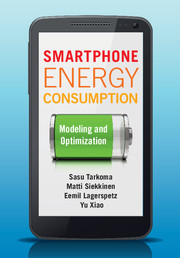Book contents
- Frontmatter
- Contents
- Preface
- List of abbreviations
- Part I Understanding energy consumption
- Part II Energy management and conservation
- 6 Overview
- 7 Smartphone subsystems
- 8 Mobile operating systems
- 9 Power modeling
- 10 Power profilers
- Part III Advanced energy optimization
- Appendix A An energy profile application
- Index
- References
7 - Smartphone subsystems
from Part II - Energy management and conservation
Published online by Cambridge University Press: 05 August 2014
- Frontmatter
- Contents
- Preface
- List of abbreviations
- Part I Understanding energy consumption
- Part II Energy management and conservation
- 6 Overview
- 7 Smartphone subsystems
- 8 Mobile operating systems
- 9 Power modeling
- 10 Power profilers
- Part III Advanced energy optimization
- Appendix A An energy profile application
- Index
- References
Summary
To develop energy-efficient techniques, the first step is to understand how energy is consumed on a mobile device. A mobile device consists of hardware components, such as microprocessors, wireless network interfaces, storage, cameras and a touchscreen, and software running on top of these hardware components. Lower-power serial buses facilitate the communication between the internal system components. These hardware components are the actual energy consumers.
Smartphone and mobile device power optimization happens on multiple levels:
• Silicon-level, in which the transistor capacitance and the chip design affect the energy efficiency. Higher capacitance requires the transistors to do more work.
• SoC-level, in which multiple power/voltage/clock domains can be used to support granular power management with the help of software. In addition, dynamic voltage and frequency scaling (DVFS) is used to dynamically adjust both the voltage and frequency to meet the given energy and performance level.
• Software-level, in which various power managers monitor and control the energy and power settings. A high-level framework is needed to perform system-wide tuning and optimization.
There are several choices that contribute critically to the overall efficiency of a mobile device, for instance from an energy-consumption viewpoint. They are the SoC including the CPU, display technology, communications technology, and the OS. The system-level power management is coordinated by the OS. In this chapter, we survey these crucial components and examine their energy consumption.
- Type
- Chapter
- Information
- Smartphone Energy ConsumptionModeling and Optimization, pp. 92 - 136Publisher: Cambridge University PressPrint publication year: 2014



